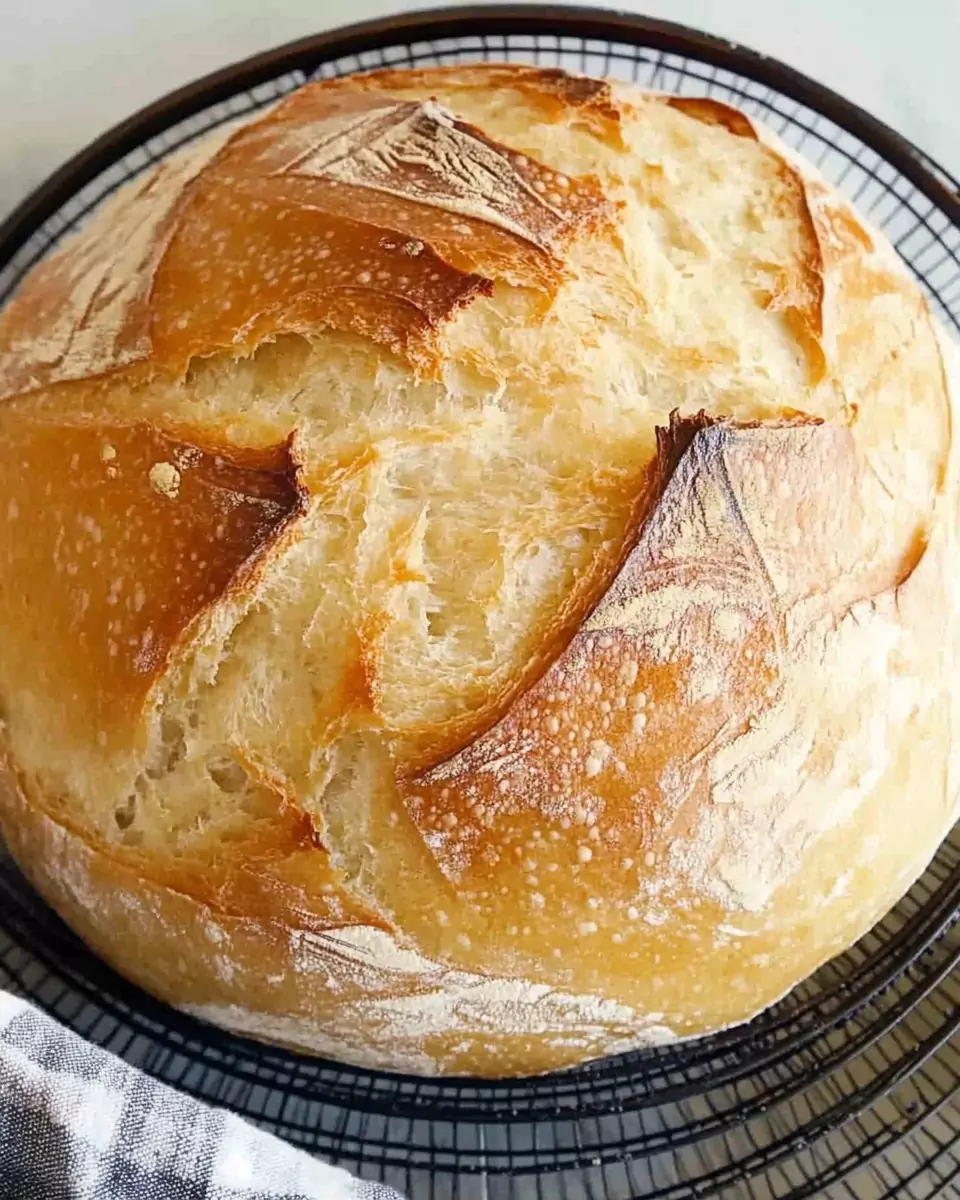Craving homemade sourdough but short on time? This speedy same-day sourdough bread recipe delivers a crusty, flavorful loaf in just a few hours. Unlike traditional sourdough recipes that require overnight fermentation, this method allows you to bake the same day while maintaining the signature tang and airy crumb of classic sourdough.
This recipe is ideal for those who want fresh bread without the long wait. It uses a simple technique of stretch and folds to build structure quickly, and a warm fermentation process to speed up the rise. Whether you’re a beginner or an experienced baker looking for a faster method, this recipe makes it easy to enjoy homemade sourdough in one day.

Essential Tools & Equipment
- Dutch oven – Creates steam for a crisp crust.
- Bread lame or sharp knife – Essential for scoring the dough before baking.
- Large mixing bowl – Used for mixing and fermenting.
- Banneton or tea towel-lined bowl – Helps shape the dough.
- Parchment paper – Prevents sticking and makes transferring easier.
- Kitchen scale – Ensures accurate ingredient measurements.
Ingredients
- 410g all-purpose flour
- 290g water
- 160g active sourdough starter
- 8g salt
Step-By-Step Instructions
1. Mix Ingredients (10 minutes)
In a large mixing bowl, combine water, sourdough starter, and salt. Stir well to ensure even distribution of the starter and salt. Add the flour and mix until all the flour is incorporated. The dough will be sticky and shaggy at this stage. Use your hands to finish mixing and form a rough dough. Cover with plastic wrap or a damp towel and let it rest for 30 minutes.
2. Stretch and Folds (1 hour)
To build gluten strength, perform four sets of stretch and folds over the next hour:
- Wet your hands and grab one edge of the dough.
- Stretch it upward, then fold it over itself.
- Rotate the bowl 90 degrees and repeat three more times.
- Cover and let the dough rest for 20 minutes between each set.
Repeat this process a total of four times over the course of an hour. This technique replaces traditional kneading and helps the dough develop structure.
3. Bulk Fermentation (3–4 hours)
Cover the bowl and let the dough ferment at room temperature until it nearly doubles in size. This usually takes about three to four hours, depending on room temperature. If the dough rises slowly, place it in a slightly warm oven with the light on to speed up fermentation.
4. Shape the Dough (10 minutes)
Lightly flour a clean surface and transfer the dough onto it. Gently stretch the dough into a rough rectangle. Fold the edges into the center to form a tight, round shape. Flip it over so the smooth side faces up. This step helps build tension for a good rise.
5. Final Proof (2 hours)
Prepare a banneton or a bowl lined with a floured tea towel. Place the dough seam-side up into the basket. Cover and let it proof for about two hours at room temperature. The dough should rise slightly but not double in size.
6. Preheat the Oven (1 hour before baking)
About an hour before baking, preheat the oven to 460°F (238°C) with a Dutch oven inside. This ensures a hot baking environment that promotes good oven spring.
7. Score and Bake (40 minutes)
Once proofed, turn the dough onto a piece of parchment paper so the floured bottom becomes the top. Use a bread lame or a sharp knife to score the surface. A deep, clean cut allows the bread to expand properly in the oven.
Carefully transfer the dough into the preheated Dutch oven. To create steam, add a splash of water between the parchment paper and the pot. Cover with the lid and bake at 460°F (238°C) for 30 minutes. Remove the lid and bake for an additional 10 minutes at 440°F (227°C) to achieve a golden-brown crust.
8. Cool and Serve (1 hour)
Once baked, remove the bread from the Dutch oven and place it on a cooling rack. Cover with a damp towel and let it cool for at least one hour before slicing. Cutting too early may result in a gummy texture as the bread continues to set while cooling.
This same-day sourdough is perfect for sandwiches, toast, or simply enjoyed fresh with butter. The short fermentation still allows for great flavor and texture, making it an excellent option for those who don’t want to wait overnight for traditional sourdough.
Serving Suggestions
1. Fresh with Butter
One of the simplest and best ways to enjoy this sourdough bread is to slice it while it’s still slightly warm and spread it with high-quality butter. The combination of a crispy crust and rich butter enhances the natural tang of the sourdough.
2. Avocado Toast
Mash ripe avocado with a little salt, lemon juice, and black pepper, then spread it over a toasted slice of sourdough. Add toppings such as poached eggs, cherry tomatoes, or red pepper flakes for extra flavor.
3. Sandwiches
The sturdy texture of sourdough makes it an excellent choice for sandwiches. Use it to make a classic turkey and cheese sandwich, a grilled cheese, or a hearty vegetable and hummus sandwich.
4. Dipping in Soups and Stews
The thick crust and chewy crumb of sourdough make it ideal for dipping into soups and stews. Try it with tomato soup, creamy potato soup, or a rich beef stew for a comforting meal.
5. Bruschetta
Toast slices of sourdough, then top them with a mixture of diced tomatoes, garlic, basil, and olive oil for a fresh and flavorful appetizer.
6. French Toast
Slightly stale sourdough is perfect for making French toast. The dense texture absorbs the egg mixture well, resulting in a rich and flavorful breakfast dish.
7. Garlic Bread
For a quick and easy garlic bread, spread softened butter mixed with minced garlic and parsley over slices of sourdough. Toast in the oven until golden brown.
8. Cheese and Charcuterie
Sourdough pairs wonderfully with cheese and cured meats. Serve it with a selection of cheeses, prosciutto, and olives for an easy appetizer or snack.
Common Mistakes and How to Avoid Them
Even with a faster sourdough method, small mistakes can impact the final result. Here are some common issues and how to fix them.
1. Dough is Too Sticky to Handle
If the dough is excessively sticky when shaping, it may be due to high hydration or insufficient gluten development. Lightly flour your hands and work surface, but avoid adding too much flour, as this can make the bread dense.
2. Bread Does Not Rise Enough
A weak or inactive sourdough starter can prevent proper fermentation. Make sure your starter is bubbly and active, doubling in size within 4–6 hours after feeding. Additionally, ensure the dough is proofed in a warm environment to speed up fermentation.
3. Crust is Too Hard or Thick
A thick, tough crust can result from overbaking or insufficient steam. To prevent this, ensure the Dutch oven is covered for the first 30 minutes of baking. If the crust is still too thick, wrap the bread in a kitchen towel after baking to soften it slightly.
4. Bread is Too Dense
If the crumb is tight and dense rather than light and airy, the dough may have been under-proofed. Let the dough rise sufficiently before baking, and perform the stretch and folds properly to build structure.
5. Scoring is Too Shallow or Deep
Shallow scoring may cause the dough to burst unpredictably, while deep scoring can lead to deflation. Use a sharp bread lame or knife and aim for a ¼-inch deep score to allow for controlled expansion in the oven.
Side Dish Pairings
Pairing this sourdough with the right side dishes can enhance its flavor and texture. Here are some excellent options:
1. Roasted Tomato Soup
A classic pairing, tomato soup balances the tangy notes of sourdough while allowing the crispy bread to soak up its rich flavors.
2. Herb Butter and Dips
Serve slices of sourdough with garlic herb butter, hummus, or olive tapenade for a flavorful side.
3. Scrambled Eggs and Avocado
For a simple breakfast, serve this bread toasted with creamy scrambled eggs and sliced avocado.
4. Smoked Salmon and Cream Cheese
The tangy, chewy texture of sourdough pairs well with smoked salmon, cream cheese, and capers for an elegant breakfast or brunch.
5. Beef or Lamb Stew
Hearty stews with rich broths complement the chewy, crusty texture of sourdough, making it perfect for dipping.
6. Charcuterie Board
Pair slices of sourdough with a variety of cheeses, cured meats, and fresh fruit for a satisfying appetizer.
7. Mediterranean Mezze Platter
Serve sourdough with a mix of hummus, tzatziki, olives, and feta cheese for a flavorful Mediterranean-style side.
8. Fresh Green Salad
A light salad with vinaigrette dressing pairs well with the richness of sourdough, making for a balanced meal.
Recipe Tips for the Best Sourdough Bread
1. Use an Active Sourdough Starter
A strong, bubbly sourdough starter is essential for a good rise. If your starter isn’t doubling in size within 4–6 hours after feeding, it may not be ready to use. Feed it at least once or twice before baking to ensure it is active.
2. Maintain Proper Dough Hydration
The dough in this recipe has a hydration level of about 70%, which makes it soft and slightly sticky. If the dough feels too wet when shaping, lightly flour your hands and work surface, but avoid adding too much flour, as it can make the bread dense.
3. Control the Fermentation Temperature
Fermentation happens faster in a warm environment. If your kitchen is cold, place the dough in a slightly warm oven with the light on or near a warm spot in your house. Avoid excessive heat, as it can cause over-proofing.
4. Perfect the Scoring Technique
Scoring allows the bread to expand properly in the oven. Use a sharp bread lame or razor blade and make a ¼-inch deep cut to direct how the bread opens during baking. If the cut is too shallow, the crust may crack unpredictably.
5. Create Steam for a Crispy Crust
Steam is essential for achieving a golden, crispy crust. The Dutch oven traps steam naturally, but adding a small splash of water between the parchment paper and the pot before covering the lid enhances this effect.
6. Let the Bread Cool Completely
Cooling is just as important as baking. Cutting into the bread too soon can result in a gummy interior. Allow it to cool for at least one hour on a wire rack before slicing.
Storage and Reheating Instructions
Storing at Room Temperature
- Once completely cooled, store the bread in a paper bag or a bread box to maintain its crisp crust.
- Avoid plastic bags, as they trap moisture and can make the crust soft.
- The bread stays fresh for 2–3 days at room temperature.
Freezing for Long-Term Storage
- Slice the bread before freezing for easy use.
- Wrap slices in parchment paper, then place them in a freezer-safe bag.
- Store in the freezer for up to 3 months.
Reheating for the Best Texture
- For whole loaves: Preheat the oven to 350°F (175°C) and bake for 10–15 minutes.
- For slices: Toast directly in a toaster or reheat in an oven at 350°F (175°C) for 5 minutes.
- Adding a small amount of water in the oven while reheating helps restore the crust’s crispness.
Frequently Asked Questions
Can I use whole wheat flour instead of all-purpose flour?
Yes, you can substitute up to 50% of the all-purpose flour with whole wheat flour. However, whole wheat absorbs more water, so you may need to add a little extra water to maintain hydration.
What if my dough isn’t rising fast enough?
A slow rise could mean your starter isn’t strong enough or the room temperature is too low. Try placing the dough in a warm environment or giving your starter extra feedings before use.
Can I skip the stretch and folds?
Stretch and folds build gluten strength, which helps create an open crumb. Skipping them may result in a denser loaf, so it’s best to include them for optimal texture.
How do I know when my bread is fully baked?
The loaf should be golden brown and sound hollow when tapped on the bottom. You can also check the internal temperature using a thermometer—bread is fully baked at 205–210°F (96–98°C).
Can I make this without a Dutch oven?
Yes. If you don’t have a Dutch oven, bake the bread on a preheated baking stone or sheet. Place a pan of hot water on the oven’s bottom rack to create steam.
What if my bread crust is too thick or hard?
A thick crust can result from overbaking or too little steam. To soften the crust, let the bread cool wrapped in a kitchen towel. You can also brush the crust lightly with water before reheating.
How do I refresh stale sourdough?
Wrap the bread in a damp towel and place it in a 300°F (150°C) oven for 10 minutes. This helps restore moisture while keeping the crust crisp.
Final Thoughts
This same-day sourdough bread provides an excellent balance between convenience and quality. While it doesn’t require an overnight fermentation, it still delivers the tangy flavor, airy crumb, and crispy crust that make sourdough so appealing.
By following the tips in this guide, you can refine your technique and achieve a perfect loaf every time. Whether enjoyed fresh, toasted, or paired with your favorite dishes, this bread is a great addition to any meal.
For those who love the process of bread baking but don’t have the patience for traditional long fermentations, this recipe offers a practical solution without sacrificing the essential qualities of sourdough.
Speedy Same Day Sourdough Bread
Ingredients
- 410 grams all-purpose flour
- 290 grams water
- 160 grams sourdough starter
- 8 grams salt
- Equipment
- 1 dutch oven
- 1 bread lame or sharp knife
Instructions
Mix Ingredients:
- In a large bowl, combine water, sourdough starter, and salt. Stir well to disperse the starter and salt evenly. Add the flour and mix until combined. Finish mixing with your hands to ensure all the flour is incorporated. Cover with an airtight material (plastic wrap, foil, or even a shower cap) and let the dough rest for 30 minutes.
Stretch and Folds:
- After 30 minutes, perform the first set of stretch and folds:
- Grab the edge of the dough, stretch it upward, and fold it under the opposite side.
- Rotate the bowl 90° and repeat, completing 4 folds in total.
- Cover the dough and let it rest for 20 minutes before repeating.
- Perform 4 total sets of stretch and folds over the course of 1 hour, covering the dough between sets to prevent it from drying out.
Bulk Fermentation:
- Once the stretch and folds are complete, cover the dough again and let it rise for 3–4 hours at room temperature, or until it nearly doubles in size.
Shape the Dough:
- Transfer the dough to a lightly floured surface. Shape it by grabbing opposite ends of the dough and pinching them together at the top. Repeat with the other two ends to form a tight, smooth ball.
Final Proof:
- Prepare a bread or banneton basket by lining it with a lightly floured tea towel. Place the dough ball into the basket, seam-side up. Cover with a plastic bag or cloth and let it rise for 2 hours at room temperature.
Preheat the Oven:
- During the final hour of proofing, preheat your oven to 460°F (238°C) with the dutch oven inside to ensure it is hot.
Score and Bake:
- Once proofed, transfer the dough to a piece of parchment paper, flipping it so the floured bottom becomes the top. Score the dough with a bread lame or sharp knife, creating a crisscross pattern.
- Carefully place the dough (with the parchment paper) into the preheated dutch oven. Add a splash of water between the parchment paper and the dutch oven to create steam. Cover with the lid and bake for 30 minutes at 460°F (238°C).
- Remove the lid and bake for an additional 10 minutes at 440°F (227°C) to achieve a golden-brown crust.
Cool:
- Remove the bread from the oven and transfer it to a cooling rack. Cover with a damp kitchen towel and let it cool for at least 1 hour before slicing.
Notes
Scoring for Success: A deep, clean cut before baking helps the bread expand properly and develop a beautiful crust.
Serving Idea: Enjoy fresh with butter, use for sandwiches, or toast for a crunchy, flavorful snack.




Leave a Comment